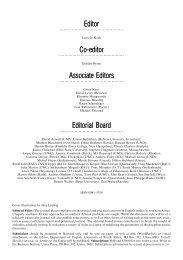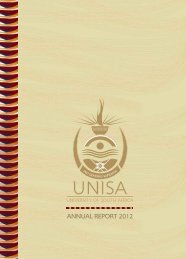pdf: 6.426kb - University of South Africa
pdf: 6.426kb - University of South Africa
pdf: 6.426kb - University of South Africa
Create successful ePaper yourself
Turn your PDF publications into a flip-book with our unique Google optimized e-Paper software.
sclerops) and the otter (Ptenorura brasiliensis) (Villarejo<br />
1979:173±176; Chirif 1980:188). In the thirties<br />
gold and oil were found in the area <strong>of</strong> Pachitea (Luna<br />
1986:27±28).<br />
In September 1932 a group <strong>of</strong> Peruvian civilians<br />
took the Colombian town <strong>of</strong> Leticia by force. A war<br />
with Colombia was the result <strong>of</strong> this action, which<br />
was supported by the government in Lima. A<br />
consequence <strong>of</strong> this was the militarization <strong>of</strong> the<br />
zone, and the forced recruitment <strong>of</strong> soldiers among<br />
the Amazonian population. In the military camps<br />
people from distant areas <strong>of</strong> all the Amazonian<br />
territories and other parts <strong>of</strong> Peru met. Local healers<br />
forced to join the army met each other, and were able<br />
to exchange ideas (Luna 1986:28).<br />
The Second World War was again to bring changes<br />
to the Amazon. In 1941 Japan rapidly advanced<br />
through <strong>South</strong> East Asia, from where most <strong>of</strong> the<br />
rubber used in the Western world came. Old Amazonian<br />
jungle tracks were reopened in search <strong>of</strong> rubber<br />
and jebe fino, attracting immigrants from the rest <strong>of</strong><br />
the Peruvian territory. In November 1971 oil was<br />
discovered in the RõÂo Tigre, and a new period <strong>of</strong><br />
expansion occurred, bringing about a demographic<br />
explosion (Luna 1986:28).<br />
Iquitos plays a central role in the administrative,<br />
economic and cultural life <strong>of</strong> north-eastern Peru. It<br />
continues to attract immigrants, not only from jungle<br />
settlements in Amazonian territories, but also from<br />
other areas <strong>of</strong> the country. With them have come their<br />
traditional beliefs and practices, and this city and its<br />
vicinity are a rich field for gathering ethnological and<br />
folkloristic information (Luna 1986:28).<br />
Despite the modern facË ade <strong>of</strong> the city <strong>of</strong> Iquitos,<br />
traditional jungle life with roots in a not so distant<br />
past, has by no means disappeared or even given<br />
ground before the impact <strong>of</strong> the hitherto coast-basal<br />
industrial society. Although the casual visitor cannot<br />
help but notice just how much twentieth-century<br />
machinery and ways have entered into jungle life (at<br />
least as far as the presence <strong>of</strong> motor-powered<br />
launches, automobiles, aeroplanes, telephones, movies<br />
and pumps, nonetheless he would find many<br />
traditional beliefs flourishing in this relatively modern<br />
urban setting. Magical beliefs flourish in this situation<br />
<strong>of</strong> culture change, as Man attempts to achieve mastery<br />
and control over the unknown by special rituals and<br />
ceremonies. Real problems are presented to the<br />
anthropologist who tries to separate the myriad<br />
strands <strong>of</strong> imported industrial society found among a<br />
small sector <strong>of</strong> the population from the admixtures <strong>of</strong><br />
beliefs held by the destitute poor or middle-income<br />
men and women who attribute illness and misfortune<br />
to witchcraft (Dobkin de Rios 1984:49).<br />
In Iquitos, much <strong>of</strong> the population, many <strong>of</strong> them<br />
landless peasants who have migrated from other areas<br />
<strong>of</strong> the country, live in barriadas or squatter settlements.<br />
Many <strong>of</strong> these peasants have very little<br />
knowledge <strong>of</strong> the Amazonian environment (Chirif<br />
1980:189). The price <strong>of</strong> food and other goods is very<br />
high, compared with those <strong>of</strong> other cities <strong>of</strong> Peru. The<br />
price <strong>of</strong> the transport <strong>of</strong> agricultural products from the<br />
chacras to the city, either by river or by road, is also<br />
high (Luna 1986:29).<br />
Down river from Iquitos, the RõÂ o Napo, a major<br />
tributary <strong>of</strong> the Amazon river, is populated by mestizos<br />
or riberenÄos, struggling in transition between the tribal<br />
situation and modern civilization. They live in casarõÂos<br />
or riverine communities on the banks <strong>of</strong> the river and<br />
make use <strong>of</strong> river transport for contact with the<br />
modern world, travelling between Iquitos and other<br />
casarõÂos. The distinction between mestizo and riberenÄo<br />
is very complicated. Luna (1991:9) defined<br />
riberenÄos as the descendants <strong>of</strong> detribalized Amazonian<br />
Indians, the <strong>of</strong>fspring <strong>of</strong> Indian-European and<br />
Indian-<strong>Africa</strong>n unions, and the descendants <strong>of</strong> early<br />
immigrants from different areas <strong>of</strong> Brazil, Peru, and<br />
other Andean countries, thus comparing well with the<br />
previously discussed definition <strong>of</strong> mestizo. RiberenÄo<br />
can however also refer to those who dwell along the<br />
riverbanks in riverine communities.<br />
These mestizos or riberenÄos live in huts, mostly with<br />
only a raised floor and ro<strong>of</strong> made out <strong>of</strong> thatched<br />
palm. Most <strong>of</strong> these huts lack any walls and furniture,<br />
except for mosquito netting in which to sleep, and an<br />
occasional hammock. The women mainly farm on<br />
their chacras (swidden gardens), with yuca (a starchy<br />
root) and plantain (cooking bananas) as the main<br />
produce. Some will sometimes run a little bodega<br />
(shop) from their house. The men are mostly fishermen<br />
and spend most <strong>of</strong> their time fishing on the river,<br />
making dugout canoes, or helping in the chacra with<br />
the more strenuous work. Most <strong>of</strong> the casarõÂos have<br />
an elementary school and soccer field. Soccer is in<br />
most cases the main recreation <strong>of</strong> riberenÄos.<br />
Most <strong>of</strong> the work is <strong>of</strong> a subsistence nature only.<br />
Some riberenÄos do send their produce and fish to<br />
Iquitos by river transport, to sell or trade for necessities<br />
like sugar, soap, tobacco, medicine, and aguardiente<br />
Ð a raw sugarcane rum, distilled by the local<br />
mestizos. Some people will also catch and sell<br />
ornamental fish for aquariums to the many tourists in<br />
Iquitos. Another alarming source <strong>of</strong> income is the<br />
making <strong>of</strong> carboÂn (charcoal) for use as fuel by the<br />
many inhabitants <strong>of</strong> Iquitos. This process entails the<br />
cutting down <strong>of</strong> hardwood trees, normally done by<br />
the father with a chainsaw, followed by his wife and<br />
children, stacking the logs up and burning it to<br />
produce the carboÂn. This has become a valuable<br />
source <strong>of</strong> income for many riberenÄos, and is one <strong>of</strong> the<br />
causes <strong>of</strong> deforestation on the riverbanks and<br />
throughout the rainforest, which is easily accessed<br />
by water ways.<br />
Because <strong>of</strong> the struggle between the tribal situation,<br />
ISSN 0256±6060±Unisa Lat. Am. Rep. 16(2) 2000 47

















